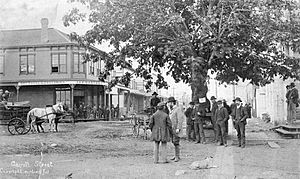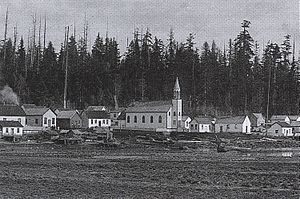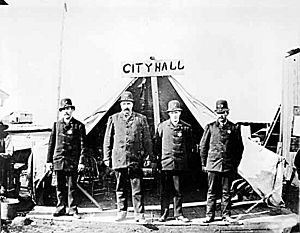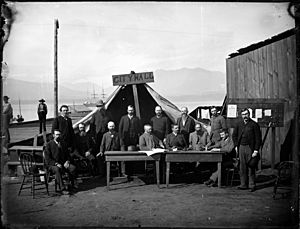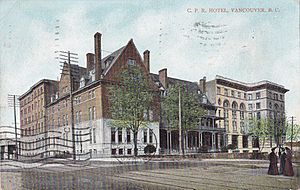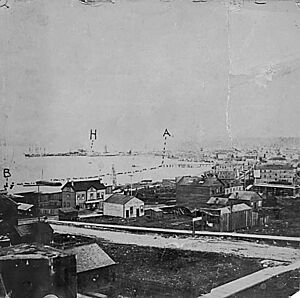Great Vancouver Fire facts for kids
Quick facts for kids Great Vancouver Fire |
|
|---|---|
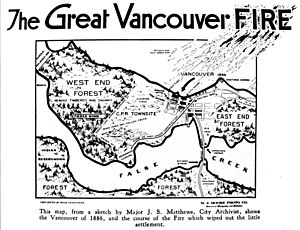
Hand drawn map of Vancouver in 1886 showing the spread of the fire
|
|
| Location | Vancouver |
| Coordinates | 49°16′59.4″N 123°06′40.6″W / 49.283167°N 123.111278°W |
| Statistics | |
| Date(s) | June 13, 1886 |
| Cause | Out of control land clearing fires |
| Buildings destroyed | 600–1,000 |
| Deaths | Exact number unknown |
The Great Vancouver Fire was a huge fire that destroyed most of the city of Vancouver, British Columbia, Canada. This happened on June 13, 1886. The city had just become official, changing its name from Granville to Vancouver.
The fire began from two smaller fires. These fires were started to clear land for building. One was for the Canadian Pacific Railway and the other for expanding the city. The fires quickly grew out of control. They spread into the city, destroying many buildings. Between 600 and 1,000 buildings were burned down. Sadly, at least 21 people died. Most people escaped by running to the water, either Burrard Inlet or False Creek.
After the fire, the people of Vancouver worked hard to rebuild. The city grew even stronger. They set up the first police force. New buildings were made of brick for safety. The first fire engine came from the nearby town of New Westminster.
Contents
Early Vancouver's Beginnings
European settlers first came to the Vancouver area in 1862. This was after Captain George Henry Richard found coal in the Burrard Inlet in 1859. The settlement was called Granville. It started in the mid-1860s. It was located between two sawmills on the Burrard Inlet.
Granville began with shops and hotels. These served the sawmill workers and their families. The two main sawmills were Moodyville (opened 1863) and Hastings Mill (opened 1867). These mills were the biggest employers. In the early 1880s, they had 150 to 200 workers. Many workers were single men who stayed only a few weeks.
Getting to Granville was not easy. You could travel nine miles through thick forest from New Westminster. Or, you could take a thirty-mile trip on the Fraser River from Fort Langley, which was the capital at the time.
In 1885, it was announced that Granville would be the end point for the Canadian Pacific Railway. This was a big deal for the town. Granville officially became the City of Vancouver on April 6, 1886. It was the fourth city in British Columbia.
On May 3, 1886, Malcolm MacLean was elected as Vancouver's first Mayor. The city was growing fast. New areas to the west were planned for future growth. These plans were made by Lachlan Hamilton of the Canadian Pacific Railway.
Who Lived in Early Vancouver?
Early Vancouver attracted many people who wanted to start new businesses. These people were very active in city politics. The population of Granville grew a lot in the early to mid-1880s. By early 1886, the area was growing so fast that three new newspapers started.
The population also changed. At first, it was mostly single men. Some families had First Nations wives. Later, more families arrived, especially with European wives.
Many Chinese migrants also came to Vancouver. Some worked at Hastings Mill. The Canadian Pacific Railway also brought Chinese railway workers. They helped build the railway's end point.
First Nations People in the Area
The main native people in the area were the hən̓q̓əmin̓əm̓-speaking Musqueam. When sawmills started in 1863, local Squamish men were hired for basic jobs. The mission reserve near Moodyville and the Indian rancheria at Hastings Mill were places where native people lived and worked.
By 1881, there were at least 500 Squamish people at Burrard Inlet. First Nations people did not have the same rights as European settlers. Men were not hired for higher-skilled jobs at the sawmills. Women could not inherit property from their white partners. They were often forced to leave their homes after their partners died.
How the Fire Started
Before the fire, Vancouver had three weeks of unusually hot weather. Sunday, June 13, was especially hot. A strong breeze blew from the Pacific Ocean. There was also a lot of dry wood and debris. This was from recent land clearing. All of this made perfect fuel for a fire.
First Land Clearing Fire
The first fire was southwest of the city. Workers were clearing land for the Canadian Pacific Railway's roundhouse. The dry weather and strong breeze made this fire grow quickly. It got out of the workers' control.
Second Land Clearing Fire
The second fire was at the west end of the city. It was near Cambie and Cordova streets. This fire was also started to clear land for the city's expansion. It also grew out of control in the early afternoon.
How the Fire Spread
Workers and volunteers tried to put out both fires. They used buckets, wet blankets, and shovels. For the first fire, they got water from False Creek. For the second fire, they used a hand pump at the Regina Hotel.
They fought the fires all afternoon. But the breeze turned into a strong wind. The men at the first fire had to give up and run to False Creek. At the second fire, they tried to dig a fire break, but it didn't work. Both fires then joined together.
Smoke filled the sky over the town. The fleeing workers warned everyone about the fire. Most residents quickly packed their things. They ran to the Burrard Inlet shore. However, some people did not believe the fire was dangerous. They waited until the very last minute to escape. The Squamish people from Snauq village paddled across in canoes to watch the fire.
At the Burrard Inlet shore, some people got onto floats and boats. At least 200 people found safety on the Robert Kerr. This was a 190-foot wooden ship anchored nearby. It was called "the ship that saved Vancouver." The local Squamish Nation also helped. They paddled canoes and rescued people from the water.
The Vancouver Volunteer Hose Company No.1 went to Scoullar's General Store. They took explosives to Hastings Mill. The city clerk, Thomas McGuian, saved the city's important records. He gave them to a stranger for safekeeping.
After the Fire
After the fire passed, Mayor Malcolm MacLean sent messages. He sent telegrams to the Canadian Prime Minister and the Mayor of Toronto. His message to Prime Minister Sir John A. Macdonald said: "Our city is ashes three thousand people homeless can you send us any government aid?"
These messages were sent by horse to New Westminster. Soon, news came that help was on the way from New Westminster. Wagons full of supplies were coming. Most Vancouver residents had gathered at Hastings Mill or False Creek. Mayor MacLean told everyone to meet at Westminster Bridge for the supplies.
A temporary camp was set up. People made tents and shelters from branches. Around midnight, supplies arrived from New Westminster and Port Moody.
What Was Damaged?
The fire destroyed between 600 and 1,000 buildings. Very few buildings survived. The Regina Hotel in the north and the Bridge Hotel in the southeast were among the few that made it. The exact number of people who died is not known. This is because Vancouver's population was changing very quickly at that time.
Rebuilding Vancouver
The day after the fire, Richard Alexander, the manager of Hastings Mill, made a big announcement. He offered free lumber to anyone rebuilding their homes and businesses. Temporary shelters were set up in the few buildings that survived. Blocks of ice found under the Deighton House ice shed provided drinking water.
The city council set up a temporary city hall in a tent. A few months later, one of Vancouver's first brick buildings became the new city hall. To stop looting, Mayor MacLean quickly appointed three special police officers. They joined constable John Stewart to form Vancouver's first police force. They worked from the city hall tent while the city was rebuilt.
In the days that followed, people set up white canvas tents and small huts. They searched through the burned remains of their homes and businesses. They hoped to find anything that survived. The CPR Hotel was the first building to be completely rebuilt.
Within two weeks, Cordova Street was busy again. Businesses reopened in simple structures. The City Council also organized for the main streets to be covered with wooden planks. Within six months, 500 buildings had been rebuilt. Many of the new buildings were made of brick, which was safer.
Vancouver's Population Grows
After the fire, the City Council focused on making Vancouver grow. The Canadian Pacific Railway was very important for this growth. It brought more people and helped the economy. It was also the biggest property owner.
In the years after the fire, Vancouver's population kept growing. From a few hundred people, it grew to 2,000 within a year. Within six years, it reached 13,000 people!


